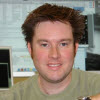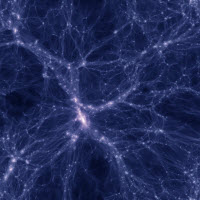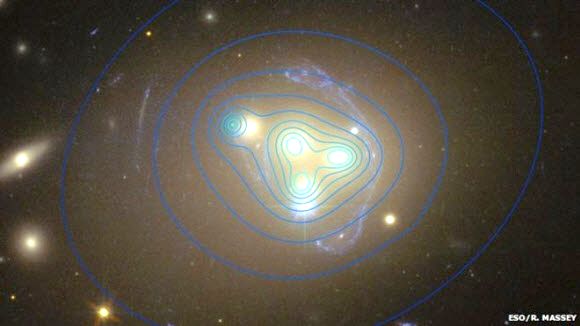
Dr Richard Massey
(Durham University)
Dr Massey’s subject matter was something we have visited several times over the years, what is stuff made of, Chemists would say elements; atoms molecules etc, Physicists would say; muons, quarks, bosons, up and down particles etc. Ask an astronomer and he would suggest 4% baryonic or ordinary matter, 23% dark matter and 73% dark energy!
 Imagine Pizza dough, said Dr Massey: kneed it, throw it and spin it into a disk. It’s the stickiness of the dough that holds it together and flattens it out into a disk. Galaxies spin around like a pizza with gravity acting as the sticky glue. Back in the 1970’s Vera Rubin however discovered that galaxies were spinning quicker than would be expected with their mass. Some extra, unseen force was at play, providing extra mass. It was also discovered that galaxy groups turning around each other also did not have enough mass to bind them together, yet they plainly were. The mass required for them to remain together was 6 times more than gravity could account for. So the theory of unseen mass ‘Dark Matter’ came about, a term coined by Fritz Zwicky.
Imagine Pizza dough, said Dr Massey: kneed it, throw it and spin it into a disk. It’s the stickiness of the dough that holds it together and flattens it out into a disk. Galaxies spin around like a pizza with gravity acting as the sticky glue. Back in the 1970’s Vera Rubin however discovered that galaxies were spinning quicker than would be expected with their mass. Some extra, unseen force was at play, providing extra mass. It was also discovered that galaxy groups turning around each other also did not have enough mass to bind them together, yet they plainly were. The mass required for them to remain together was 6 times more than gravity could account for. So the theory of unseen mass ‘Dark Matter’ came about, a term coined by Fritz Zwicky.
 Astronomers now believe dark matter filaments were already present in the fledging universe before the formation of any galaxies. Galaxy clusters were in essence bolted to this invisible scaffold. The trouble is how do you detect the invisible? One way is to look for signs of gravitational lensing the field Dr Massey is currently working in. Light rays can be bent by massive objects such as massive galaxies. Using the HST to map the night sky astronomers look for distorted images, signs of the glue holding everything together.
Astronomers now believe dark matter filaments were already present in the fledging universe before the formation of any galaxies. Galaxy clusters were in essence bolted to this invisible scaffold. The trouble is how do you detect the invisible? One way is to look for signs of gravitational lensing the field Dr Massey is currently working in. Light rays can be bent by massive objects such as massive galaxies. Using the HST to map the night sky astronomers look for distorted images, signs of the glue holding everything together.
For the first time however, dark matter may have been caught interacting within a galaxy cluster, Abell 3827, located 1.4 billion light-years away. Although the dark matter cannot be seen, the team was able to deduce its location using the technique of gravitational lensing, bending the path of light passing nearby, in this case from a distant galaxy, which happened to be aligned just right for the team's purpose. When Dr Massey and colleagues previously studied collisions between enormous conglomerations of galaxies, they found that the dark matter hardly slowed down, but in this case they found that one dark matter clump appeared to be lagging behind the galaxy it surrounds. Such a lag between the dark matter and its associated galaxy would be expected if the mysterious stuff was interacting with itself - through forces other than gravity.

Distribution of dark matter in the cluster is shown with blue contour lines.
Image: ESO/Richard Massey
This slight interaction requires exotic physics, challenging our fundamental theories of particle physics and General Relativity. One potential candidate is the least massive of the (as-yet unobserved) super symmetric particles, and while it is widely believed to be associated with a specific particle, the current theory of physics known as the Standard Model does not account for one, almost all current scientific knowledge concerns only the (few percent) baryons.
Dr Massey did warn that it was too early to say if this is a dark matter effect, or caused by normal astrophysical processes. But it may specify the lower limit of interaction. Simulations will have to be run of these collisions to distinguish these possibilities
Further research by Richard's team has also been published placing an upper limit of the interaction of DM with its surroundings
To further his research, Dr Massey and his team have recently developed and built a new detecting scope called SuperBIT – a low cost solution to perhaps detecting DM particles. Soaring to an altitude around 99% above Earth’s atmosphere, the mission almost ended in disaster when the balloon and instrument package landed less than 30m from a river.
Dr Massey concluded by saying
"We are finally homing in on dark matter from above and below - squeezing our knowledge from two directions."
The Large Hadron Collider will take another approach to cracking the mystery during its second run, which began this month. The giant machine under the French-Swiss border will search for dark matter particles by smashing protons together at unprecedented energies.
The Q&A after Richard's talk was also illuminating. One person from the audience asked whether dark matter could be a new particle. Yes, said Richard: in fact experience shows that particles tend to come in families, so dark matter could consist of a number of new particles. Andi pursued this theme further: could dark matter respond to as-yet undiscovered fundamental forces of nature; and given the ratio of dark matter to barionic matter could there be several families of particles covered by dark matter? Yes, Richard confirmed: we can't rule that out. In spite of the knowledge about dark matter that we're gaining, it's clearly still a deep mystery.
- Log in to post comments

